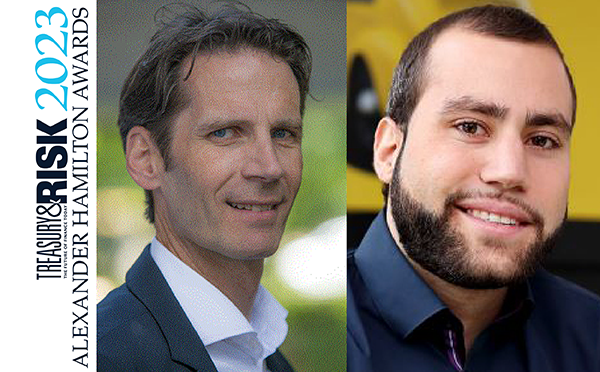
Amway sells consumer products in more than 100 countries andterritories, and until recently its accounts payable (A/P)processes were highly decentralized. The finance function wasmaking progress in consolidating global workflows, but paymentscontinued to be handled in the business units. In total, divisionsaround the world used more than 100 different banks. They processedpayments with different technologies, controls, and approvalprocesses.
|“Each country had its own individual finance team, with its ownway of doing things,” explains Jeff May, former supervisor forglobal treasury at Amway. “That put us in a difficult position asfar as visibility to cash flows. Corporate treasury relied on thebusiness units to provide information about their payments byfilling out a spreadsheet and emailing it to us once a month. Ifsomeone was out sick, we might not get the data—and when we did getthe data, it didn't always match what we saw in the general ledger[G/L].”
|The treasury team set out to implement a standardized globalpayments process and payment hub technology with straight-throughconnectivity to the company's banks. They also wanted to supportthe replacement of an outdated mainframe-based G/L system that hadbeen built in-house years earlier. Finally, they aimed torationalize the large number of banks Amway worked with.
|The project represented a massive overhaul of payments across alarge and diverse business. “At first, it was challenging to getthe entire world on board with our ideas,” May admits. “Wecollaborated with a global change management team that was workingwith Amway divisions around the world on the transition to a newERP [enterprise resource planning] system. We joined their changemanagement efforts, including participating in training sessions toexplain what we were wanting to do.”
| As the company deployed the newERP system, treasury rolled out a Kyriba treasury management systemand undertook a bank rationalization project that ultimatelyreduced the company's payment banks by about 50 percent.“Initially, there was hesitation from internal business partners onreconsidering our payment banks. They would say, 'We need to keepall our banks for X, Y, and Z reasons,'” May says. “Of course,there are countries that require unique treatment for regulatoryreasons. We worked hard to understand those and determine where wereally couldn't standardize. But as we explained to business groupshow we were going to handle payments going forward, it became clearthat the processes would be much more efficient if we rationalizedour banks. The banks we retained were those that could slot intothe new workflow.”
As the company deployed the newERP system, treasury rolled out a Kyriba treasury management systemand undertook a bank rationalization project that ultimatelyreduced the company's payment banks by about 50 percent.“Initially, there was hesitation from internal business partners onreconsidering our payment banks. They would say, 'We need to keepall our banks for X, Y, and Z reasons,'” May says. “Of course,there are countries that require unique treatment for regulatoryreasons. We worked hard to understand those and determine where wereally couldn't standardize. But as we explained to business groupshow we were going to handle payments going forward, it became clearthat the processes would be much more efficient if we rationalizedour banks. The banks we retained were those that could slot intothe new workflow.”
When the treasury management and ERP system rollouts had provensuccessful, Amway began routing all payments, in every businessunit around the world, through one of four regional finance sharedservice centers. Now business units initiate payments and businessmanagers approve those payments within the ERP system. After apayment has all the right approvals in place, it is added to theERP system's payment file.
|The ERP system automatically sends payment files to eachregional shared service center's payment hub. There, the Kyribapayment module determines the appropriate format for each bank'spayment file and the bank's preferred method of connectivity,whether a host-to-host connection with the bank portal or a SWIFTtransmission. The payment files are reviewed and released, and thepayment hub automatically transmits the file to the bank.
|After a bank receives a payment file, it automatically sendsback a payment acknowledgement in the form of an ACK or NACKmessage. The acknowledgements flow into a dashboard that sharedservice center staff can use to understand in real time whichpayments were processed successfully. Likewise, prior-day bankstatements flow straight through into the treasury managementsystem on a daily basis. The ERP system's cash management moduleautomatically reconciles the bank statements with ERP payment dataand alerts shared service center staff to any exceptions.
|“This new process is very streamlined,” says May. “Like always,there are exceptions. In certain countries, local requirementsmandate that specific payments go through processes that are notour standard workflow. But for the vast majority of our paymentsaround the world, we've eliminated a lot of unnecessary steps thatused to waste time and cause payment delays in our legacyenvironment.”
|
See also:
- On-demand webcast: How to Leverage Payment Innovations andEfficiencies
- Custom-Built Software Streamlines Currency-ControlsCompliance
- Improving Efficiency of Global TravelSourcing
- 2019 Alexander Hamilton Awards in TechnologyExcellence
|
May estimates that the company is saving more than 600 hours amonth that staff would have spent on manual payment-relatedactivities and managing spreadsheets in the prior environment.“When you're operating in more than 100 different countries and youconsolidate and eliminate manual activities across all of those,staff have a lot more time to work on strategic initiatives,” hesays. “We've also found that this change has boosted morale becausemaintaining our cash flows doesn't require so much tedious busywork.”
|The standardized controls and enhanced visibility into paymentshave significantly reduced the chance that Amway will fall victimto payments fraud. And the centralized understanding of cash flowsenables the treasury team to make better use of funds and reduceworking capital globally. “Previously, we could only seepoint-in-time and end-of-month balances,” May says. “We couldn'tsee the day-to-day ups and downs of our global cash position. So wereally didn't have a good sense of how to fund those cash flows.Now the payments dashboard gives us that visibility. Our cashforecasts are much better. We can be sure we have the desiredamount in each account, and the rest can be swept into our regionalcash pools.”
|May attributes the project's success to the continued,enthusiastic support of senior management, and to the persistenceof the treasury team. To bring an initiative like this to fruition,he says, “you have to make sure you stick to the standardizationprocess. In some countries, you will get pushback. We encounteredmany situations where people initially believed that they had tocontinue doing things the way they had always been done. There werenumerous occasions where we could have been talked into makingexceptions even though exceptions really weren't necessary. But westayed focused on our vision, we kept talking to and listening toour business partners, and we kept asking 'Why?' Through thiseffort, we were able to standardize processes across most of ourglobal businesses.”
Complete your profile to continue reading and get FREE access to Treasury & Risk, part of your ALM digital membership.
Your access to unlimited Treasury & Risk content isn’t changing.
Once you are an ALM digital member, you’ll receive:
- Critical Treasury & Risk information including in-depth analysis of treasury and finance best practices, case studies with corporate innovators, informative newsletters, educational webcasts and videos, and resources from industry leaders.
- Exclusive discounts on ALM and Treasury & Risk events.
- Access to other award-winning ALM websites including PropertyCasualty360.com and Law.com.
*May exclude premium content
Already have an account? Sign In
© 2024 ALM Global, LLC, All Rights Reserved. Request academic re-use from www.copyright.com. All other uses, submit a request to [email protected]. For more information visit Asset & Logo Licensing.






